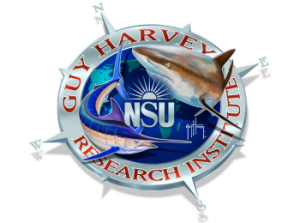NSU Newsroom
SharkBytes
Horizons
This version of NSU News has been archived as of February 28, 2019. To search through archived articles, visit nova.edu/search. To access the new version of NSU News, visit news.nova.edu.
This version of SharkBytes has been archived as of February 28, 2019. To search through archived articles, visit nova.edu/search. To access the new version of SharkBytes, visit sharkbytes.nova.edu.
Shortfin Mako Shark Makes a Direct Bee-Line South – But to Where?
FORT LAUDERDALE-DAVIE, Fla.– February 21, 2014 –
Researchers say a juvenile shortfin mako shark tagged more than eight months ago off Ocean City, Maryland is tracking a highly unusual path directly south in the mid-Atlantic – a fast track to a mystery destination.
“I’ve never seen one act quite like this one,” said Mahmood Shivji, Ph.D., director of Nova Southeastern University’s (NSU) Guy Harvey Research Institute (GHRI) and Save our Seas Shark Center. “The mako is displaying an amazingly directed movement – as if this shark has a specific destination it wants to get to in a hurry,” he added, pointing to a computer screen showing the nearly straight vertical path of a young male mako, dubbed I-NSU.
The public can also follow I-NSU in near real-time, courtesy of an interactive online website set-up by GHRI (www.nova.edu/ocean/ghri/tracking/). The tracking website is an educational outreach component of GHRI’s quest to study shark migration patterns, with the ultimate goal being to better understand and protect them, as some species are threatened or endangered.
Shivji and his GHRI team have satellite tagged and tracked several species of sharks. I-NSU is among 16 mako sharks tagged with special satellite-linked devices allowing GHRI researchers to monitor their movements. The research team has a particular interest in mako shark behavior and conservation. In addition to being the NSU athletics mascot, this fast swimming species is also under heavy fishing pressure. In fact, three of the nine mako sharks GHRI started tracking in 2013 were captured in commercial longline fisheries.
NSU’s GHRI began tagging mako sharks in 2009 to study their migratory patterns and now undertakes expeditions worldwide to study these amazing animals. The school’s marine experts have tagged mako sharks as far away as Mexico and New Zealand. In addition to makos, GHRI and Save Our Seas Shark Research Center scientists are also tracking tiger, oceanic white tip and sand tiger sharks, as well as blue marlin.
Shivji said tagged sharks, though many do traverse thousands of miles, often move in irregular patterns, sometimes even crossing over previous tracks and frequently changing directions.
“I-NSU also showed an irregular and looping pattern for four months when it was exploring northern latitudes, but at some point it decided it was time to get somewhere directly south and has been on a virtual straight track for the last nearly 1,100 miles,” he said.
Is the shark on a mission to reach a destination?
“I guess we will just have to wait and see,” said Shivji. “It certainly hasn’t been meandering for the past 26 days. It sure looks like it’s focused on getting somewhere specific.”
###
About Nova Southeastern University: Situated on 314 beautiful acres in Fort Lauderdale, Florida, Nova Southeastern University (NSU) is a dynamic, fully accredited research institution dedicated to providing high-quality educational programs at all levels. NSU is a not-for-profit independent institution with an enrollment of 27,000 students. NSU awards associate’s, bachelor’s, master’s, specialist, doctoral and first-professional degrees in a wide range of fields. NSU is classified as a research university with “high research activity” by the Carnegie Foundation for the Advancement of Teaching, and it is one of only 37 universities nationwide to also be awarded Carnegie’s Community Engagement Classification. For more information, please visit www.nova.edu. Celebrating 50 years of academic excellence!
About NSU’s Guy Harvey Research Institute: Established in 1999, the Guy Harvey Research Institute (GHRI) at NSU is collaboration between the renowned marine artist, scientist and explorer, Dr. Guy Harvey, and Nova Southeastern University’s Oceanographic Center. The mission of the GHRI is to provide the scientific information necessary to understand, conserve, and effectively manage the world’s marine fishes and their ecosystems. The GHRI is one of only a handful of private organizations dedicated exclusively to the science-based conservation of marine fish populations and biodiversity. The research, education and outreach activities of the GHRI are supported by the Guy Harvey Ocean Foundation, AFTCO Inc., extramural research grants, philanthropic donations by private businesses and individuals, and NSU. http://www.nova.edu/ocean/ghri/index.html
Media Contacts:
Joe Donzelli | Office of Public Affairs
954-262-2159 (office)
954-661-4571 (cell)
jdonzelli@nova.edu
John Bell | Guy Harvey Ocean Foundation
954-766-2794 (office)
954-684-5155 (cell)
prseitz@bellsouth.net
